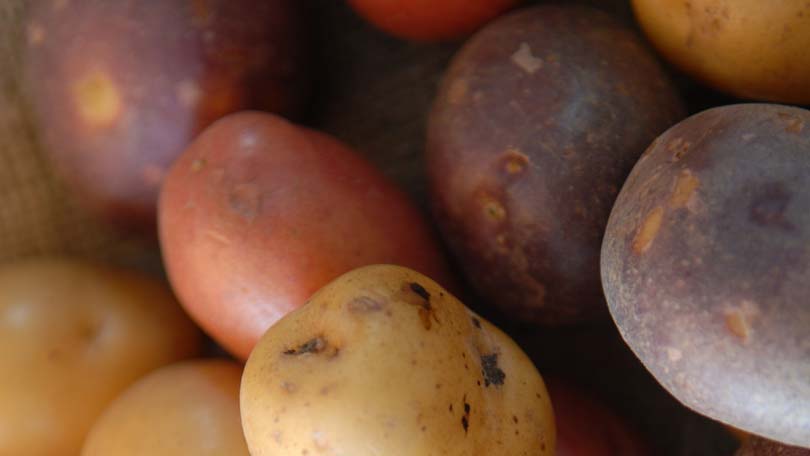
Potatoes are one of the most common foods found today. But, do you ever wonder how this came to be. Where do potatoes come from? What is their history?
The life of the potato began around 7,000 years ago in the high plateau of the Andean Mountains of South America, which is known today as the Titicaca Plateau and which stretches across the modern countries of Peru and Bolivia. In this region at elevations of up to 15,000 feet the Aymara Indians were able to develop and cultivate more than two hundred varieties of the potato. These potatoes formed the main basis of the Aymara Indian and the Incan diet. These natives were impressed by the durability, ruggedness, storage quality and nutritional value this vegetable of the earth offered them. Potatoes also influenced the Incan culture, as potato shaped pottery (with even eyes) is found commonly at excavation sites. Also Incan units of time were correlated to the length of time it took for a potato to cook to various consistencies. In the Incan world potatoes were even used to predict the weather.
Europeans were not exposed to the potato until the late 1400s and 1500s when the Spanish Conquistadors sacked Peru. When they did not find the silver and gold they were looking for they quickly took over the potato market. From here potatoes were soon a standard supply item on Spanish ships and it was noted that sailors who ate papas (potatoes) did not suffer from scurvy (a disease associated with a deficiency in vitamin C) because potatoes are packed with vitamin C. Though the potato was very productive and hardy, the Spanish did not really embrace it and it was considered a food for the underclass.
After Spain introduced the potato to Europe it would take another three decades before its knowledge was spread to the rest of the European nations. Even when this occurred it was only at first mainly cultivated by amateur botanists as a curiosity thing. Resistance to the growth and consumption of potatoes was due to established eating habits, the potatoes reputation as a food for the underprivileged and also the fact that it has a relationship to poisonous plants, being poisonous at times itself.
Potato cultivation in Europe did spread slowly and eventually hit the Low Countries and Switzerland. In the 1620’s the spud was introduced to Germany and here the nutritional properties of the potato were finally acknowledged as Frederick the Great, the Prussian Ruler ordered the German people to eat potatoes as a deterrent to famine. People’s fears of poisoning from the plant led Frederick to enforce this decree by threatening those who did not consume the spuds with the idea of cutting of their ears and noses. In response to this, by the time of the Seven Years War potatoes were a basic part of the Prussian diet.
During the time of the Seven Years War (1756-63) a certain French intellectual, Antoine Augustine Parmentier was a prisoner of war in Prussia. Here he saw, first hand, the nutritional benefits of the potato and he realized that its productive capacity could be a real boom for the French farmer. He became obsessed with the crop and when he returned to France, where he was a pharmacist, chemist and an employee of Louis the 15th, he set out to make the potato a staple of the French diet. When he failed to convince his fellow Frenchman of the advantages of potatoes by conventional means he thought up a scheme. Parmentier acquired some unproductive land on the outskirts of Paris. Here he planted 50 acres of potatoes and set a guard over this land. The presence of the guard grew considerable attention in the neighborhood and in the evening when the guard was mostly relaxing the locals came to see what all the fuss was about. Thinking that this plant must be valuable many peasants took some of the potatoes from the plot to their own home gardens to be grown. He helped to overcome many of his fellow Frenchman’s initial resistance to the vegetable with their own curiosity and desire to better their lot with this obviously valuable (due to presence of the guard) new produce taking them over. Therefore, Parmentier achieved his goal, although he spread the potato in a very sneaky and unique way.
The potato would not gain true prominence however until the 1780’s when this rugged food crop was adopted by the Irish; who adopted this crop for the prime reason that it could be abundantly produced and was nutritious. Soon after this the potato would gain acceptance across Europe. It would eventually make its way back across the Atlantic to North America with many of those who were migrating here. As time passed and as still follows today potatoes have become one of the world’s major food stuffs. In fact, these oval or often misshapen vegetables are so common in the Western diet that they are often taken for granted. We should appreciate this great food and realize that they have only truly been with us for a few hundred years but have a history and have traveled a journey that none of us would ever repeat.
